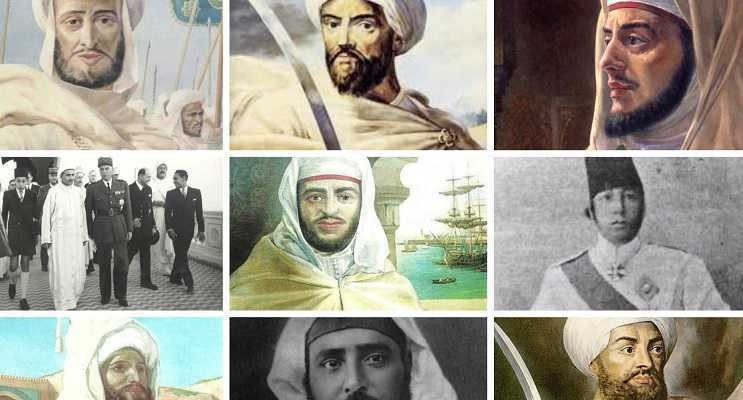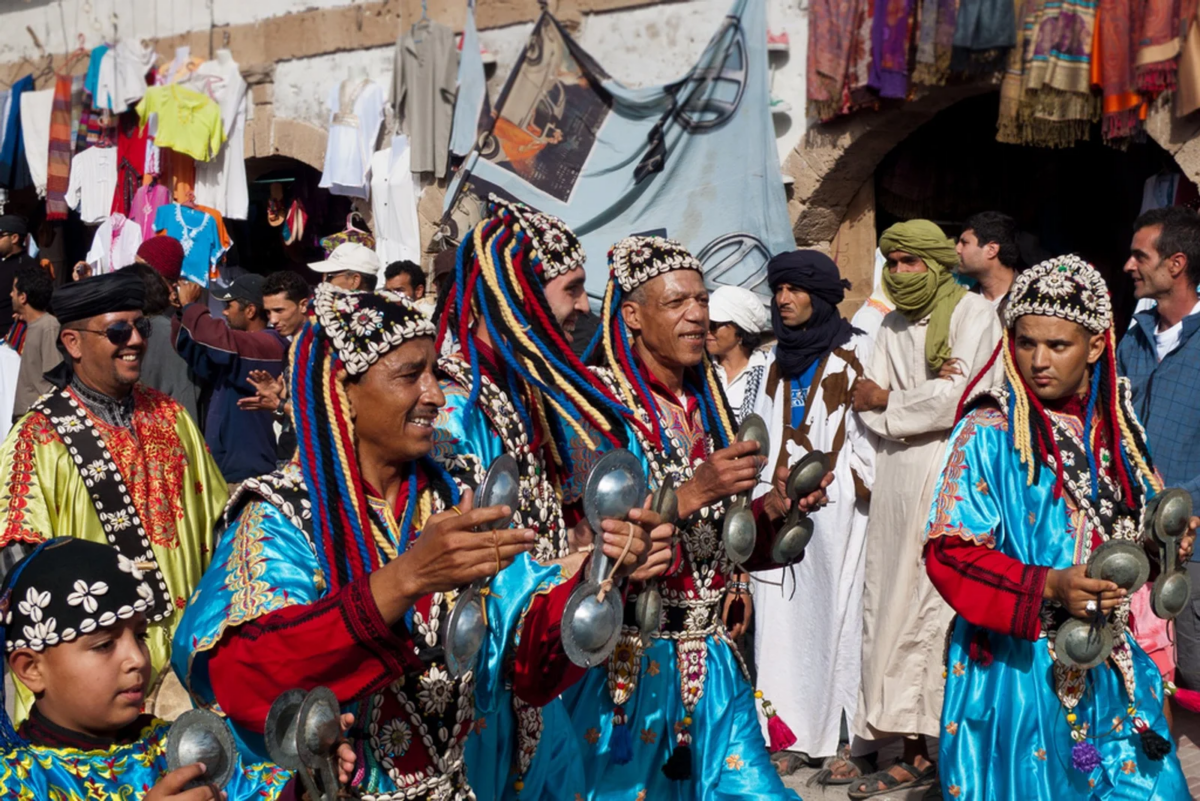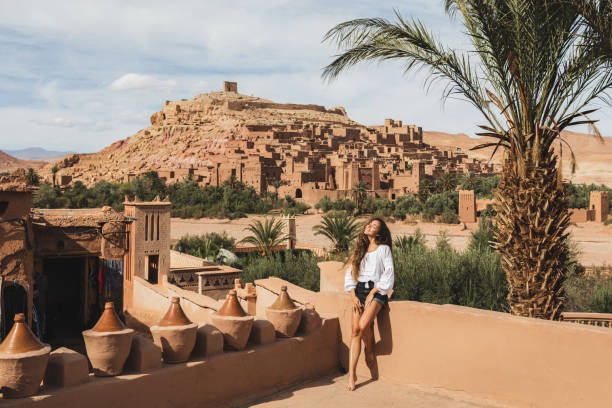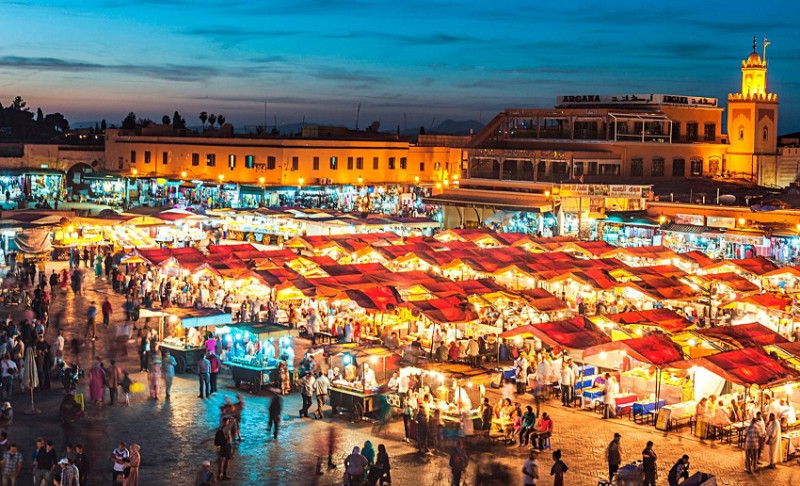Morocco, a country known for its rich culture and history, is situated on the Northwest corner of the African continent. This diverse land is a crossroads where African, Arab, and European cultures intertwine, creating a unique mosaic of cultural experiences. From its sun-drenched Mediterranean coastline to the bustling souks of Marrakech and the rugged Atlas mountains, Morocco offers an unparalleled richness and diversity that leaves a lasting impression on its visitors. This profile will delve into the many facets that make up this vibrant nation.
Key Facts
Before plunging into the manifolds of Morocco, let’s outline some facts about this country.
- Capital: Rabat
- Languages Spoken: Arabic, Amazigh, French, and Spanish
- Currency: Moroccan Dirham (MAD)
- Government: Constitutional Monarchy
- Major Religions: Islam, Christianity, and Judaism
- Famous For: The Atlas Mountains, Sahara Desert, and its distinct blend of Arab, Berber, and European cultural influences.
Geography and Climate
Morocco’s geography is incredibly diverse, boasting a spectrum of landscapes that range from coastal plains to mountain ranges and vast desert expanses. The country is bordered by the Atlantic Ocean and the Mediterranean Sea to the west and north, providing a lengthy coastline that is dotted with beautiful beaches and bustling port cities. Canyons, oases, and the renowned ‘blue city’ of Chefchaouen add further to the visual splendor. Inland, the terrain rises to the rugged Atlas Mountains, dividing the country into coastal regions and the Sahara Desert in the south.
The Moroccan climate varies with the geography. Coastal regions enjoy a Mediterranean climate with warm, dry summers and mild, wet winters. In contrast, the Atlas Mountains are cooler, with snow-capped peaks during winter months, and the Sahara region is characterized by extreme heat and aridity. This variety in both geography and climate contributes to Morocco’s incredible biodiversity and its wide range of outdoor activities for visitors. Read Also: 30 Interesting Facts about the Africa Cup of Nations (AFCON)

History
The history of Morocco is as diverse as its landscapes, colored by the influences of numerous cultures and civilizations. The earliest known inhabitants, the Berbers, have lived in the region since at least 2000 B.C., establishing the foundation of Moroccan culture. Phoenician traders later influenced the area and were then incorporated into the Roman Empire around the first century A.D. After the fall of Rome; the region fell under Byzantine rule before the arrival of the Arabs in the 7th century, introduced Islam and Arabic language to the local Berber tribes.
During the Middle Ages, Morocco was part of the Islamic world, with local dynasties such as the Almoravids and the Almohads spreading their power over large parts of Spain, North Africa, and the western Saharan region. In the 19th century, European powers showed increasing interest in Morocco. This lead to the Treaty of Fez in 1912, which made Morocco a protectorate of France and Spain.
Morocco gained independence in 1956, largely through the efforts of the Istiqlal (Independence) Party and the Sultan, Mohammed V. A constitutional monarchy was established in 1962 with Mohammed V as the King. Since then, Morocco has seen significant development and modernization while still preserving its rich cultural heritage and history.

Culture and Traditions
Moroccan culture is a vibrant fusion of Berber, Arab, French, Jewish and other African influences. This rich cultural heritage is visible in every aspect of Moroccan life, from architecture, cuisine, music, and dance to the way of life of its people.
Traditional Moroccan architecture is a visual feast of intricate tilework, carved wood, and geometric designs—best embodied in the nation’s numerous palaces, mosques, and medinas. The houses, known as Riads, often have an internal courtyard showcasing stunning zellige tile work and a garden. Read Also: 10 African Countries with the Best Street Food Culture
Music and dance are vital components of Moroccan culture, with different regions having their unique styles. The traditional Berber music, known as Ahidus, features rhythmic dance, while the Gnawa music, rooted in African Islamic Mysticism, is a hypnotic blend of percussion and string instruments. Traditional Arab and Andalusian classical music also plays a significant role, with instruments such as the oud (a type of lute) and darbuka (a goblet drum) commonly used.
Traditional Moroccan clothing includes the ‘djellaba’—a loose, hooded robe worn by both men and women and the ‘kaftan’ worn by women on special occasions. The red fez hat and the yellow ‘babouches’ (slippers) are also iconic in Morocco. Moroccan women put their feelings, experiences, and messages to their beloved into carpet drawings. Moroccan rugs come in two types – Rabat and Berber.
Religion
Islam is indeed the dominant religion, with Sunni Muslims making up the majority. The Maliki school of thought, which emphasizes community consensus, is prevalent here. The religious festivals and cultural events throughout the year further add to Morocco’s cultural richness. Ramadan, the holy month of fasting, is observed by all, and the ending is celebrated with Eid al-Fitr. The Gnaoua World Music Festival in Essaouira and the Rose Festival in El Kelaa M’gouna are major cultural events attracting locals and tourists alike.
Moroccan traditions and customs are deeply rooted in hospitality, respect, and community. Moroccan people are known for their warm and generous hospitality. It is customary to be invited for a meal and served mint tea as a sign of friendship and welcome.

Food and Cuisine
Moroccan cuisine is one of the country’s many cultural highlights, with the fusion of Mediterranean, Arabic, Andalusian, and Berber influences. Renowned for its bold flavors and diverse dishes, it’s characterized by the use of dried fruits, fresh vegetables, meat, and various herbs and spices, including saffron, cumin, coriander, and cinnamon. At the heart of Moroccan cuisine is couscous, a staple dish traditionally served with a hearty stew.
Moroccan cuisine has more in common with Middle Eastern cuisine than with the rest of Africa. Bread is a big part of the daily meal, and it is principally made from durum wheat semolina, known as khobz. Tagines, named after the conical clay pot they’re cooked in, is another quintessential Moroccan dish. They are slow-cooked savory stews, typically made with sliced meat, poultry or fish, and vegetables or fruit. There are many variations of tagine, including the popular chicken tagine with olives and preserved lemon.
Mint tea, also known as Moroccan whiskey, is more than just a drink in Morocco. It’s a sign of hospitality, friendship, and tradition. Served throughout the day, it is a drink of choice after meals. Sweets and pastries are also essential to Moroccan cuisine, with honey, almonds, and dates being common ingredients. These sweet treats offer a perfect ending to a meal or as an accompaniment to mint tea.
Street Food
Moroccan street food is legendary, with different delectable options that reflect the country’s rich culinary heritage. The best place to immerse yourself in this gastronomic adventure is Djemaa el-Fna, a bustling square in Marrakech that transforms into a large open-air restaurant as the sun sets. Here are some popular Moroccan street foods to sample:
- Harira: A hearty soup made from tomatoes, lentils, chickpeas, rice, chunks of lamb, and plenty of earthy spices like turmeric and cinnamon. It’s a staple during the holy month of Ramadan.
- Merguez: This is a spiced sausage made from lamb or beef. Its flavor is enhanced by the use of a variety of spices.
- Sardines: Grilled sardines are a popular street food, especially on the south coast of Morocco. They are enjoyed for their fresh, savory taste.
- Maakouda: These are potato patties often served with a fiery tomato salsa. They are a common sight in the street food stalls of Morocco.
- Babbouche: This distinct snail soup is made from over 15 herbs and spices, offering a unique flavor profile.
- Sfenj: A Moroccan take on the doughnut, Sfenj is often served with honey or powdered sugar.
- Shawarma: A Middle Eastern-style sandwich made with meat, vegetables, and sauces. Despite its Middle Eastern origin, it’s a popular grab-and-go food in Morocco.
- Almond milkshake: A refreshing and creamy drink made with almonds, perfect to cool off during a hot Moroccan day.
- Sugared peanuts: Coated in a red sugary shell, these peanuts are a popular sweet snack.
- Hendia: Prickly pears, a fruit popular in Morocco as a street food, especially during the late summer through early winter.

Tourist Attractions
Morocco beckons tourists with an enticing mix of history, culture, and stunning natural landscapes. Top among the destinations is the vibrant Marrakesh Medina, a historic walled city teeming with bustling souks and architectural marvels. Chefchaouen offers a tranquil retreat with its distinctive blue-washed buildings and stunning mountainous backdrop if you are drawn to unique urban aesthetics. For those enticed by the allure of the vast desert, the mesmerizing Erg Chebbi’s dunes in the Sahara present a stunning golden vista.
History enthusiasts will find their retreat in Fes el Bali, a UNESCO-listed medieval city appreciated for its ancient architecture and traditional atmosphere. Another UNESCO World Heritage site, Ait Ben Haddou, offers a glimpse into the past with its well-preserved mud-brick ksar (fortified village). The coastal town of Essaouira is a charming entanglement of a picturesque medina and a laid-back atmosphere, offering a taste of Moroccan coastal life. Yet another link to the past is Volubilis, an ancient Roman city with well-preserved ruins.
Dades Valley’s dramatic rock formations and scenic landscapes offer a visual treat, while the verdant Rif Mountains promise excellent hiking opportunities and breathtaking views. Finally, the magnificent Hassan II Mosque in Casablanca, intricately designed and overlooking the Atlantic Ocean, showcases the splendor of Moroccan architecture.
The different attractions display Morocco’s diverse cultural, historical, and natural heritage, making the country a captivating destination for all types of travelers. So, whether you are keen on exploring ancient ruins, immersing yourself in the hustle and bustle of city life, or marveling at stunning natural landscapes, Morocco has a unique experience waiting for you.

Economy and Industries
Morocco’s economy is considered a diverse one, with key sectors including agriculture, mining, and manufacturing. The country is the world’s largest exporter of phosphates, a key component in fertilizer, which is central to the mining sector. Agriculture remains a crucial part of the economy, employing about 40% of the country’s workforce. Key agricultural products include cereals, olives, citrus fruits, and, notably, Morocco is the world’s third-largest producer of saffron.
The manufacturing sector has grown significantly in recent years, particularly in the automotive industry. Morocco has become the largest car manufacturer in Africa, surpassing South Africa, with several global car manufacturers setting up production plants.
Tourism also contributes significantly to the nation’s economy, with Morocco being one of the most visited countries in Africa. Its diverse culture, rich history, and stunning landscapes attract visitors from around the globe. Additionally, the Moroccan government has invested heavily in the renewable energy sector, specifically solar energy, aiming to make the country more energy-independent and a leading global solar power provider.
The information technology sector is emerging as a promising field, with Morocco positioning itself as an offshore center for IT services. The Moroccan government has enacted various initiatives to attract foreign direct investment, including tax incentives and improved infrastructure, which has led to steady economic growth. However, challenges such as high youth unemployment and income inequality persist.



